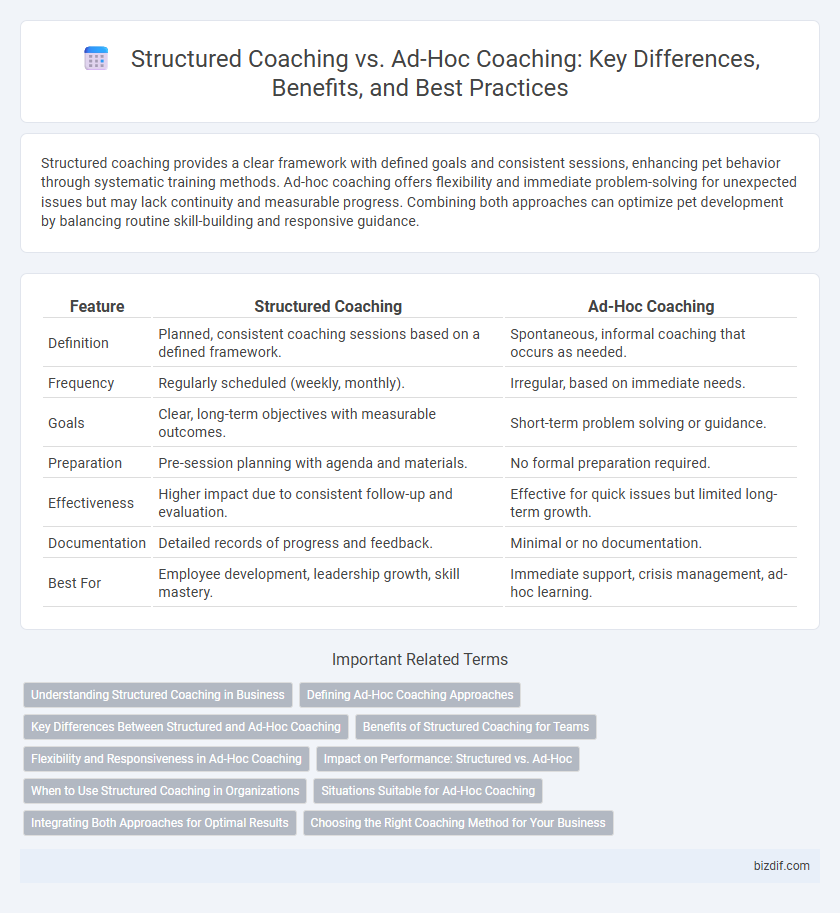Structured coaching provides a clear framework with defined goals and consistent sessions, enhancing pet behavior through systematic training methods. Ad-hoc coaching offers flexibility and immediate problem-solving for unexpected issues but may lack continuity and measurable progress. Combining both approaches can optimize pet development by balancing routine skill-building and responsive guidance.
Table of Comparison
| Feature | Structured Coaching | Ad-Hoc Coaching |
|---|---|---|
| Definition | Planned, consistent coaching sessions based on a defined framework. | Spontaneous, informal coaching that occurs as needed. |
| Frequency | Regularly scheduled (weekly, monthly). | Irregular, based on immediate needs. |
| Goals | Clear, long-term objectives with measurable outcomes. | Short-term problem solving or guidance. |
| Preparation | Pre-session planning with agenda and materials. | No formal preparation required. |
| Effectiveness | Higher impact due to consistent follow-up and evaluation. | Effective for quick issues but limited long-term growth. |
| Documentation | Detailed records of progress and feedback. | Minimal or no documentation. |
| Best For | Employee development, leadership growth, skill mastery. | Immediate support, crisis management, ad-hoc learning. |
Understanding Structured Coaching in Business
Structured coaching in business involves a systematic approach with clearly defined goals, timelines, and measurable outcomes that align with organizational objectives. This method enhances employee development through consistent sessions, documented progress, and tailored strategies based on individual performance metrics. Organizations leveraging structured coaching experience improved skill acquisition, higher engagement, and increased return on investment compared to ad-hoc coaching models.
Defining Ad-Hoc Coaching Approaches
Ad-hoc coaching approaches involve spontaneous, flexible interactions tailored to immediate needs without a predefined structure or schedule. This coaching style prioritizes responsiveness and situational problem-solving, enabling coaches to address real-time challenges as they arise. Unlike structured coaching, ad-hoc coaching emphasizes personalized support through informal conversations rather than systematic frameworks or long-term plans.
Key Differences Between Structured and Ad-Hoc Coaching
Structured coaching follows a defined framework with scheduled sessions, clear objectives, and measurable outcomes, ensuring consistent progress and accountability. Ad-hoc coaching occurs spontaneously, addressing immediate needs without a formal plan, which offers flexibility but may lack continuity and long-term impact. The key differences lie in consistency, goal alignment, and the methodical approach that structured coaching provides versus the reactive and situational nature of ad-hoc coaching.
Benefits of Structured Coaching for Teams
Structured coaching enhances team performance by providing consistent, goal-oriented guidance that aligns with organizational objectives. Regular feedback loops and predefined milestones facilitate measurable progress and accountability within teams. This systematic approach fosters skill development, improves communication, and drives sustained productivity growth.
Flexibility and Responsiveness in Ad-Hoc Coaching
Ad-hoc coaching delivers superior flexibility and responsiveness, allowing coaches to address immediate challenges and tailor guidance in real-time without rigid schedules. Unlike structured coaching, which follows a set curriculum, ad-hoc coaching adapts dynamically to individual needs and evolving circumstances, fostering rapid problem-solving and personalized support. This approach enhances engagement by providing timely interventions that directly align with the coachee's current priorities.
Impact on Performance: Structured vs. Ad-Hoc
Structured coaching consistently drives measurable performance improvements by aligning goals with tailored development plans and regular progress assessments. Ad-hoc coaching may offer immediate problem-solving benefits but often lacks the sustained impact due to its reactive, sporadic nature. Organizations implementing structured coaching report higher employee engagement, skill retention, and long-term productivity compared to those relying on informal, impromptu coaching sessions.
When to Use Structured Coaching in Organizations
Structured coaching is most effective in organizations during periods of significant change, such as implementing new technologies or leadership development initiatives, where consistent goals and measurable outcomes are critical. It provides a systematic approach with defined timelines and frameworks, ensuring alignment across teams and clear progress tracking. Organizations seeking to build long-term skills and embed cultural shifts benefit greatly from the disciplined methodology of structured coaching.
Situations Suitable for Ad-Hoc Coaching
Ad-Hoc Coaching is ideal for situations requiring immediate feedback or support, such as addressing sudden performance issues or navigating unexpected challenges. It suits scenarios where quick problem-solving or skill adjustments are necessary without the framework of a long-term plan. This approach fosters agility and responsiveness in dynamic workplace environments.
Integrating Both Approaches for Optimal Results
Combining structured coaching frameworks with ad-hoc coaching sessions leverages the strengths of both planned development and spontaneous guidance, enhancing overall effectiveness. Structured coaching provides clear goals, tracking, and accountability, while ad-hoc coaching addresses immediate challenges and fosters adaptability. Integrating these methods creates a dynamic coaching environment that supports sustained growth and rapid problem-solving.
Choosing the Right Coaching Method for Your Business
Structured coaching offers a systematic approach with clear goals, consistent progress tracking, and tailored development plans that align with your business objectives. Ad-hoc coaching provides flexibility and immediate support for specific challenges, ideal for dynamic environments requiring quick interventions. Selecting the right coaching method depends on your company's size, culture, and desired outcomes, ensuring alignment with both strategic priorities and employee needs.
Structured Coaching vs Ad-Hoc Coaching Infographic

 bizdif.com
bizdif.com